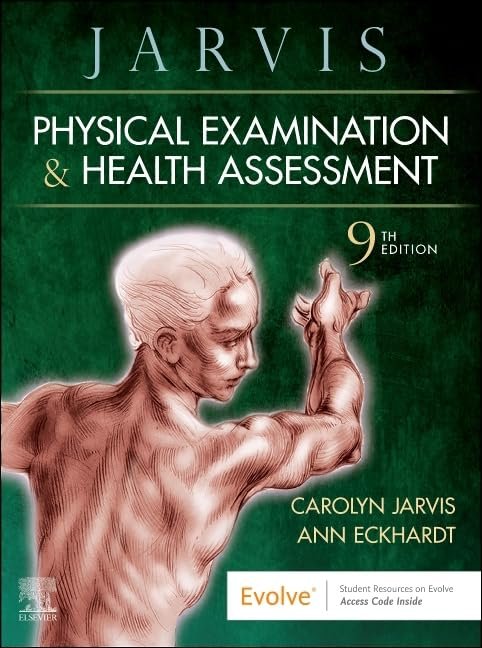Test bank for Physical Examination and Health Assessment, 9th Edition
$26.00 Original price was: $26.00.$23.00Current price is: $23.00.
Instant PDF download of the Test Bank for Physical Examination and Health Assessment (9th Edition) by Carolyn Jarvis & Ann L. Eckhardt. NCLEX-style health assessment questions with verified answers & rationales—ideal for nursing students, NCLEX, ATI & HESI prep.

Description
Why Choose This Test Bank?
- Edition-specific: Aligned with the 9th Edition by Jarvis & Eckhardt
- Exam relevance: NCLEX, ATI, and HESI formatted questions
- Answers & Rationales: Provided for every question
- Instant delivery: PDF download, usable on any device
Table of Contents Coverage
- Evidence-Based Assessment
- Cultural Assessment
- The Interview
- The Complete Health History
- Mental Status Assessment
- Substance Use Assessment
- Family Violence and Human Trafficking
- Assessment Techniques and Safety in the Clinical Setting
- General Survey and Measurement
- Vital Signs
- Pain Assessment
- Nutrition Assessment
- Skin, Hair, and Nails
- Head, Face, and Neck, and Regional Lymphatics
- Eyes
- Ears
- Nose, Mouth, and Throat
- Breasts, Axillae, and Regional Lymphatics
- Thorax and Lungs
- Heart and Neck Vessels
- Peripheral Vascular System and Lymphatic System
- Abdomen
- Musculoskeletal System
- Neurologic System
- Male Genitourinary System
- Anus, Rectum, and Prostate
- Female Genitourinary System
- The Complete Health Assessment: Adult
- The Complete Physical Assessment: Infant, Young Child, and Adolescent
- Bedside Assessment and Electronic Documentation
- Pregnancy
- Functional Assessment of the Older Adult
Sample Questions — Chapter 1
1. After completing an initial assessment of a patient, the nurse has charted that his respirations are eupneic and his pulse is 58 beats per minute. What type of assessment data is this?
- a. Objective
- b. Reflective
- c. Subjective
- d. Introspective
Answer: A
Rationale: Objective data is what the health professional observes by inspecting, percussing, palpating, and auscultating. Subjective data is what the person says during history taking. Reflective and introspective are not used to describe data.
2. A patient tells the nurse that he is very nervous, nauseous, and “feels hot.” What type of assessment data is this?
- a. Objective
- b. Reflective
- c. Subjective
- d. Introspective
Answer: C
Rationale: Subjective data is what the person says about him or herself during history taking. Objective data is what the health professional observes by inspecting, percussing, palpating, and auscultating during the physical examination. The terms reflective and introspective are not used to describe data.
3. What do the patient’s record, laboratory studies, objective data, and subjective data combine to form?
- a. Database
- b. Admitting data
- c. Financial statement
- d. Discharge summary
Answer: A
Rationale: The objective and subjective data together with the patient’s record and laboratory studies, form the database. The other items are not part of the patient’s record, laboratory studies, or data.
FAQs — Physical Examination & Health Assessment (9th Edition)
Is this test bank aligned with the 9th Edition?
Yes. All questions are designed to match the chapters of the 9th Edition by Jarvis & Eckhardt.
Do questions include rationales?
Yes. Every item has a correct answer and many include rationales to help reinforce learning.
How do I receive the file?
You will receive a secure PDF download link instantly after checkout, plus a copy in your email and account dashboard.
Can I use it on my phone or tablet?
Yes. The PDF opens on iOS, Android, Windows, and macOS devices without special software.
Download & Start Studying Today
- Instant PDF download
- Accessible on any device
- Trusted resource for nursing assessment exams
Only logged in customers who have purchased this product may leave a review.
Related products
-
Sale!

Abrams’ Clinical Drug Therapy: Rationales for Nursing Practice, 13th Edition Test Bank
$26.00Original price was: $26.00.$23.00Current price is: $23.00. Add to cart -
Sale!

Test Bank for Community/Public Health Nursing: Promoting the Health of Populations, 8th Edition
$26.00Original price was: $26.00.$23.00Current price is: $23.00. Add to cart -

Test Bank for Keltner’s Psychiatric Nursing, 9th Edition
$23.00 Add to cart -
Sale!

Test Bank — Davis Advantage for Understanding Medical-Surgical Nursing, 7th Edition
$26.00Original price was: $26.00.$23.00Current price is: $23.00. Add to cart


Reviews
There are no reviews yet.